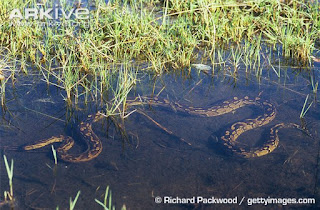 |
| An African rock python. |
The African Rock Python is the
largest of all snakes found slithering around in Africa and may reach or exceed
an impressive length of 6 metres (20 ft). However, males from this
non-venomous species of snake, usually reach 5 metres while female reach 4.25
metres in length. There are two subspecies of this
incredibly large snake; one is found in Central and Western Africa while the
other is found in parts of Southern Africa. The species from Southern African
is generally smaller than its relative living in Central and Western Africa.
This snakes' thick body is a
grey-green or brownish colour covered in blotches, ranging from a mix of brown,
olive, chestnut to yellow colours, often merging up into a wide and
asymmetrical stripe. On the crown of their heads they are marked with a large
spearhead shape while a triangular shaped marking of dark and light bands run
from each eye to their lip. Their scales are small and smooth and their teeth sharp
and curved backwards, delivering a painful bite anchoring into the victim, that
if left untreated may lead to a nasty infection. Pythons have two functioning
lungs unlike the majority of snakes only have one. They also have small and
visible pelvic spurs which are believed to the remains of hind legs from
prehistoric times.
Habitat
Both sub-species are found in
sub-Saharan Africa, with Northern African rock pythons living in parts of
Central and West Africa and the Southern African rock python found living in
parts of Southern African countries such as Kenya and South Africa among
others.
 |
| African rock python. |
Depending on which subspecies of
African rock python, they live in a wide range of habitats, which include
savannahs, woodlands, grasslands, forests, semi-deserts and rocky areas,
avoiding very dry desert areas. They often live in areas where a permanent
source of water can be found such as swamps, lakes or along river banks.
Behaviour
They are solitary animals and will
only seek out other pythons during breeding season. Due to their large size
they mainly stay on ground but are able to climb if need be. They are great
swimmers and can even stay submerged under water for long periods of time.
Although mostly nocturnal they will bask in the sun during the day soaking in
the sun’s rays for thermoregulation purposes. These snakes have a reputation
for being aggressive and unpredictable, and will bite and constrict if feeling
very threatened or unable to escape.
Diet
The African Rock python has
heat-sensitive pits positioned near their lips, which are used to detect the
location of warm-blooded animals that could be potential prey and are even able
to pick up their location in the dark.
After capturing the prey, the python
coils around it, tightening its grip with each breath of the victim, causing
crushing of internal organs and suffocation; this method is called
constriction. It will then eat the prey whole which leads to large meals taking
months to digest.
 |
| Submerged in a swamp. |
They have a carnivorous diet,
feeding mostly on large rodents, monkeys, warthogs, antelopes, fruit bats,
monitor lizards and even crocodiles in the wild but if they find themselves in
suburban areas they will eat rats, poultry, dogs and goats.
Reproduction
Once reaching the age of sexual maturation
between 3 to 5 years, African rock pythons seek out one another when the mating
season arrives in spring. Females lay between 50 to 50 hard-shelled, elongated eggs
in the safety of an old animal burrow, termite mound or cave.
She coils around
the eggs in order to protect them from predators till they hatch around 65 to
80 days later. The mother will also guard her python babies from predators for
up to 2 weeks after hatched. Juvenile African rock pythons appear like duplicates
of adult pythons expect more brightly coloured.
Did you know?
These carnivorous snakes are preyed
upon by hyenas, wild dogs and big cats such as leopards.

No comments :
Post a Comment